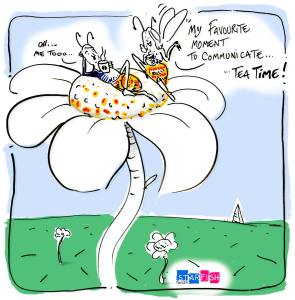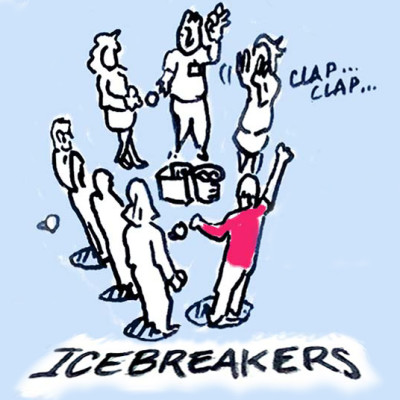The Undeniable Truth about Icebreakers.
Are you ready for an icebreaker?
Yeah, we thought so.
Icebreakers suck!
But what if…they didn’t? What if you’ve just been breaking the ice wrong all these years? Quite frankly, if we never have to guess which of 3 “facts” is a lie, or which playing card is glued to our forehead without a well-manned, open bar within arms reach, it will be too soon. There must be a better way.
So first, okay, we confess: We use icebreakers a lot! While we won’t go so far as to tattoo a flashy red heart on our arms, icebreakers are in our hearts and in a meeting or workshop they can be a tremendously useful tool, here’s why:
Participants get up, move around, quickly interact and meet a few strangers (or at least people they don’t know very well!).
They offer an easy way to allow participants to explore the meeting space, see what tools they will be using such as flipcharts and whiteboard walls — it feels like a practice round.
It’s a great way to allow everyone to speak early – every voice adds value. Introducing themselves and reporting back the icebreaker broadcasts the notion that everyone is invited to speak and participate in the workshop.
Finally, it’s an easy, no-risk moment in what might be a very intense workshop — plus it can be a lot of fun! (more on that later).
Often the first reflex is to avoid the icebreaker. Ah, you say, everybody knows everybody already; we don’t need to waste our time. Well, except the 4 new people and the guys in from Scranton, and you start to waver. But then Dwight pipes up and says, “You know what, icebreakers suck!” and the idea is quashed. You decide it’s easier to go around the room and have everybody say their name. The thing is, Dwight is wrong not only for the reasons already mentioned, but because you can really set the tone and theme of a workshop using a simple, targeted icebreaker. It’s critical to keep one in the agenda, even if we haven’t yet convinced you it isn’t any better than a necessary evil! Stick with us!
The Secret of Great Icebreakers
What is the secret to a great icebreaker, you ask? Well, it has to offer an avenue to humor, an opportunity to share something personal, and it must be relevant to the workshop and topic at hand. The first two are pretty much self-explanatory, but what do we mean by “relevant”?
Let’s step back. In a future blog we will be talking about the most common workshop mistakes and how to avoid them, and one of the overriding themes is to avoid wasting people’s time. Participants can forgive a lot, and really will follow the herd and engage on solving problems in some ridiculous ways, some of which they’d probably never even consider on their own. But once you get too close to the wind and allow participants to start thinking a) why are we doing this, b) this doesn’t make any sense, or c) we’ve already done this, that’s the point you risk losing them and their energy. Now there are reasons why you might tempt that fate as you push participants’ brain outputs to the limit, but let me say right now: The icebreaker is not one of those moments!
So by relevant we mean making efforts to tie the icebreaker and outputs into the very fabric of the workshop. You can bring one or several key topics into a lighthearted, easy exercise that introduces participants to key terminology and themes of the workshop. And while it is intended as a quick exercise, it can often bring up points or references that are repeated throughout the workshop.
The Process
The process doesn’t need to be complicated and can work just like any breakout session you might have planned. It is better if you can get people to stand up, move around, and find somebody they don’t know very well. At smaller meetings this is harder especially if the room is a typical meeting room, but there are workarounds such as inviting everyone to grab a cup of coffee when they find their partner. Incentive!
The icebreaker should generally be fast, say 10-15 minutes max, and is usually best if started immediately after an opening introduction by the lead organizer or facilitator. You will want to give clear instructions, but they can be verbal or handed out as written instructions (especially if there are options). Once completed, each individual should very quickly introduce themselves to the overall group, and as an ‘icebreaking team’ report back their work.
Some great Icebreakers examples:
When participants are coming together (mergers, new staff, not many know each other): Brainstorm all the things you have in common, the winning team will have the most unique or unusual match! Maybe we aren’t so different after all!
For smaller meetings: Turn to the person next to you and discuss favorite hobbies or pastimes, then each person must sketch a portrait of their partner. It’s a great way to get laughs and identify the artists in the room.
Medium sized meetings: Create a Top 3 list targeting anything relevant to the meeting (objectives hoped to achieve, enablers they can bring to an eventual solution, examples of other businesses/industries that face similar challenges), or not directly relevant but related, such as favorite management books, websites, apps, or event meeting hacks!
Language is an issue: Find common ground using international sports teams, which ones they like, and why the teams are successful even when they speak multiple languages and have cultural differences. An alternative could be to define a preset list of key terms so everybody knows what means what from the start.
Project Launch: Ask the teams to name the project and design a logo – you can limit this by adding requirements, such as it must look like a superhero logo, include key company elements, or be in the form of a fish!
Larger Workshops: Usually you will need to group the teams into 3-4 or more participants to save time on the introductions and report back, so here ideas such as describing the project in terms of a movie, sports team, or historical figure will allow teams to quickly identify what positive elements they share with their selection, and allow for quick comprehension by the larger group.
Time is limited: Predefine a few or several categories such as functional groupings (HR, Finance, IT, etc.) or others that are relevant to the workshop objectives and use Post-it Notes for participants to add their single best idea for that category. After introductions, move on with the meeting and ensure people are asked to review the ideas during the next coffee break.

What an Icebreaker Achieves
By the end of the icebreaker exercise, hopefully you’ve had a few laughs, people have a sense of the personalities involved and you are in position to get down to the business at hand. Thanks the to icebreaker process, you will have achieved several key points in relation to the participants and the workshop as a whole:
- People know each other, and everyone has spoken to the group.
- We’ve begun the all-important process of building trust in the group as teams learn to work in parallel.
- We have begun learning the process of hitting the high-points of a topic in a constrained time. This helps people
learn to quickly discard bad ideas and focus on moving toward a solution. To be honest, at this stage of a workshop
it’s less important that they find a Top 3 and more important that they go through the communication process of
building the list. Later in the workshop, we will need people to debate about deeply important topics and reach a
consensus. This exercises launches that process. - A gallery of the icebreaker flipcharts or Post-its can be displayed to remind participants what was important enough
to become a Top 3, for example, and allow late arrivals to quickly catch up if needed.
So don’t skip the icebreaker, it will be an easy win for your workshop and get things moving quickly. And remember, it doesn’t need to suck (got that, Dwight?).
If you would like to learn more about icebreakers, our favorite facilitation techniques, and how to make your workshop or meeting a success, sign up to Starfish Taylor blog here.




Pingback: Meeting Hack: Using Music As A Tool to Enhance Your Workshop Sessions